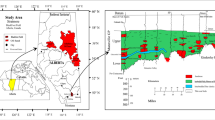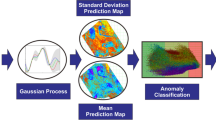Abstract
Reservoir characterization is one of the most challenging tasks that help in modeling different lithological properties like porosity, permeability and fluid saturation using seismic readings like velocity profile, impedance, etc. Such a model is required for field development, placing new wells and prediction management. Seismic attributes are being progressively utilized for the tasks of model building, exploration and properties estimation from the data. However, these tasks become very complex due to the nonlinear and heterogeneous nature of subsurface properties. In this context, present work proposes a recurrent neural network-based learning framework to classify porosity using seismic attributes as predictor variables. The approach begins by calculating different seismic attributes from the data. From the initially calculated attribute set, features that are to be used for classification are selected by using two different strategies. Firstly, the seismic attributes having good correlation strength with reservoir porosity are extracted. Subsequently, generative topographic map is utilized to select the significant features. The final reduced features set obtained by the integrated result of above two strategies is then fed as an input to the empirical mode decomposition (EMD) algorithm. The denoised features resulting from the EMD algorithm are used to train the classification models. Further, a comparison is carried out between the proposed classification framework \((EMD+RNN)\) and other supervised classifiers to show the performance of the proposed framework.






Similar content being viewed by others
Abbreviations
- \(s_t\) :
-
State at timestamp t
- \(W, U, V, W_\mathrm{f}, W_\mathrm{b}, W_\mathrm{o}\) :
-
Weight parameters
- \(b_\mathrm{f}, b_\mathrm{i}, b_\mathrm{i}\) :
-
Bias parameters
- \(x_t\) :
-
Input at timestamp t
- \(o_t\) :
-
Output at timestamp t
- \(c_t\) :
-
Cell state at timestamp t
- \(h_{t-1}\) :
-
Output at previous timestamp
- \(\sigma , \text {softmax}, \text {ReLU}\) :
-
Activation functions
- S(t):
-
Input signal
- \(\nabla\) :
-
Gradient
- \(m_t\) :
-
Average of past gradients
- \(v_t\) :
-
Average of past squared gradients
- \(\beta _1, \beta _2, \theta\) :
-
Parameters
- \(m_t, v_t\) :
-
Biased corrected parameters
- \(\eta\) :
-
Learning rate
- \(\rho\) :
-
Correlation coefficient
References
Lake LW Jr, Carroll HB (1986) Reservoir characterization, vol 1. Academic Press, Cambridge
Chopra S, Marfurt KJ (2007) Seismic attributes for prospect identification and reservoir characterization, vol 11. Society of Exploration Geophysicists Tulsa, Oklahoma
Kearey P, Brooks M, Hill I (2013) An introduction to geophysical exploration. Wiley, New York
Brown AR (2011) Interpretation of three-dimensional seismic data. Society of Exploration Geophysicists and American Association of Petroleum Geologists
Robinson ES (1988) Basic exploration geophysics
Tiab D, Donaldson EC (2015) Petrophysics: theory and practice of measuring reservoir rock and fluid transport properties. Gulf Professional Publishing, Houston
Dake LP (2001) The practice of reservoir engineering (revised edition), vol 36. Elsevier, Amsterdam
Goodman HE (1995) Method for determining rock mechanical properties using electrical log data. US Patent 5,416,697
Dolberg DM, Helgesen J, Hanssen TH, Magnus I, Saigal G, Pedersen BK (2000) Porosity prediction from seismic inversion, Lavrans Field, Halten Terrace, Norway. Lead Edge 19(4):392–399
Gastaldi C, Biguenet JP, De Pazzis L (1997) Reservoir characterization from seismic attributes: an example from the peciko field (Indonesia). Lead Edge 16(3):263–266
Hampson DP, Schuelke JS, Quirein JA (2001) Use of multiattribute transforms to predict log properties from seismic data. Geophysics 66(1):220–236
Chopra S, Marfurt KJ (2005) Seismic attributes a historical perspective. Geophysics 70(5):3SO–28SO
White RE (1991) Properties of instantaneous seismic attributes. Lead Edge 10(7):26–32
Russell B, Hampson D, Schuelke J, Quirein J (1997) Multiattribute seismic analysis. Lead Edge 16(10):1439–1444
Van der Baan M, Jutten C (2000) Neural networks in geophysical applications. Geophysics 65(4):1032–1047
Helle HB, Bhatt A, Ursin B (2001) Porosity and permeability prediction from wireline logs using artificial neural networks: a North Sea case study. Geophys Prospect 49(4):431–444. https://doi.org/10.1046/j.1365-2478.2001.00271.x
Dorrington KP, Link CA (2004) Geneticalgorithm/neuralnetwork approach to seismic attribute selection for welllog prediction. Geophysics 69(1):212–221
Parra JO, Iturrarn-Viveros U, Parra JS, Xu PC (2014) Neural network and rock physics for predicting and modeling attenuation logs. In: SEG technical program expanded abstracts. Society of Exploration Geophysicists, pp 633–637
Chaki S, Verma AK, Routray A, Mohanty WK, Jenamani M (2016) A novel framework based on SVDD to classify water saturation from seismic attributes. CoRR http://arxiv.org/abs/1612.00841
Verma AK, Chaki S, Routray A, Mohanty WK, Jenamani M (2014) Quantification of sand fraction from seismic attributes using neuro-fuzzy approach. J Appl Geophys 111:141–155
Naimi S, Shadizadeh S, Riahi M, Mirzakhanian M (2014) Estimation of reservoir porosity and water saturation based on seismic attributes using support vector regression approach. J Appl Geophys 107:93–101
Mojeddifar S, Kamali G, Ranjbar H (2015) Porosity prediction from seismic inversion of a similarity attribute based on a pseudo-forward equation (PFE): a case study from the North Sea Basin, Netherlands. Pet Sci 12(3):428–442
Rafik B, Kamel B (2017) Prediction of permeability and porosity from well log data using the nonparametric regression with multivariate analysis and neural network, Hassi R’Mel Field, Algeria. Egypt J Pet 26(3):763–778
Elkatatny S, Mahmoud M, Tariq Z, Abdulraheem A (2018) New insights into the prediction of heterogeneous carbonate reservoir permeability from well logs using artificial intelligence network. Neural Comput Appl 30(9):2673–2683
Lopes RL, Jorge AM (2018) Assessment of predictive learning methods for the completion of gaps in well log data. J Pet Sci Eng 162:873–886
Jamalian M, Safari H, Goodarzi M (2018) Permeability prediction using artificial neural network and least square support vector machine methods. In: 80th EAGE conference and exhibition 2018
Zahmatkesh I, Kadkhodaie A, Soleimani B, Golalzadeh A, Azarpour M (2018) Estimating Vsand and reservoir properties from seismic attributes and acoustic impedance inversion: a case study from the Mansuri oilfield, SW Iran. J Pet Sci Eng 161:259–274
Ahmadi MA, Chen Z (2018) Comparison of machine learning methods for estimating permeability and porosity of oil reservoirs via petro-physical logs. Petroleum. https://doi.org/10.1016/j.petlm.2018.06.002
Christopher M, Svensn Markus, Williams Christopher KI (1998) GTM: the generative topographic mapping. Neural Comput 10(1):215–234
Tan PN, Kumar V (2006) Introduction to data mining. Pearson Education India, New Delhi
Mandic DP (2001) Chambers: recurrent neural networks for prediction: learning algorithms, architectures and stability. Wiley, New York
Seismic data repository. https://www.opendtect.org/osr/. Accessed 10 Nov 2017
Huang NE, Shen Z, Long SR, Wu MC, Shih HH, Zheng Q, Yen NC, Tung CC, Liu HH (1998) The empirical mode decomposition and the Hilbert spectrum for nonlinear and non-stationary time series analysis. In: Proceedings of the royal society of london a: mathematical, physical and engineering sciences, vol 454. The Royal Society, pp 903–995
Gaur P, Pachori RB, Wang H, Prasad G (2018) A multi-class EEG-based bci classification using multivariate empirical mode decomposition based filtering and riemannian geometry. Expert Syst Appl 95:201–211
Bedi J, Toshniwal D (2018) Empirical mode decomposition based deep learning for electricity demand forecasting. IEEE Access 6:49144–49156
Famili A, Shen WM, Weber R, Simoudis E (1997) Data preprocessing and intelligent data analysis. Intell Data Anal 1(1):3–23
Gibson I, Amies C (2001) Data normalization techniques. US Patent 6,259,456
Guyon I, Elisseeff A (2003) An introduction to variable and feature selection. J Mach Learn Res 3(Mar):1157–1182
Hall MA (1999) Correlation-based feature selection for machine learning. PhD thesis, The University of Waikato
Bedi J, Toshniwal D (2018) Attribute selection based on correlation analysis. Advances in big data and cloud computing. Springer, Singapore, pp 51–61
Bedi J, Toshniwal D (2018) SFA-GTM: seismic facies analysis based on generative topographic map and RBF. arXiv preprint arXiv:1806.00193
Premanode B, Vonprasert J, Toumazou C (2013) Prediction of exchange rates using averaging intrinsic mode function and multiclass support vector regression. Artif Intell Res 2(2):47
Kingma, Diederik P, Jimmy Ba (2014) Adam: a method for stochastic optimization. arXiv preprint arXiv:1412.6980
Gunn SR (1998) Support vector machines for classification and regression. ISIS Tech Rep 14(1):5–16
Nasrabadi NM (2007) Pattern recognition and machine learning. J Electron Imaging 16(4):049901
Acknowledgements
Funding was provided by Ministry of Human Resource Development.
Author information
Authors and Affiliations
Corresponding author
Ethics declarations
Conflict of interest
The author(s) declare(s) that there is no conflict of interest.
Additional information
Publisher's Note
Springer Nature remains neutral with regard to jurisdictional claims in published maps and institutional affiliations.
Rights and permissions
About this article
Cite this article
Bedi, J., Toshniwal, D. Features denoising-based learning for porosity classification. Neural Comput & Applic 32, 16519–16532 (2020). https://doi.org/10.1007/s00521-019-04165-1
Received:
Accepted:
Published:
Issue Date:
DOI: https://doi.org/10.1007/s00521-019-04165-1




